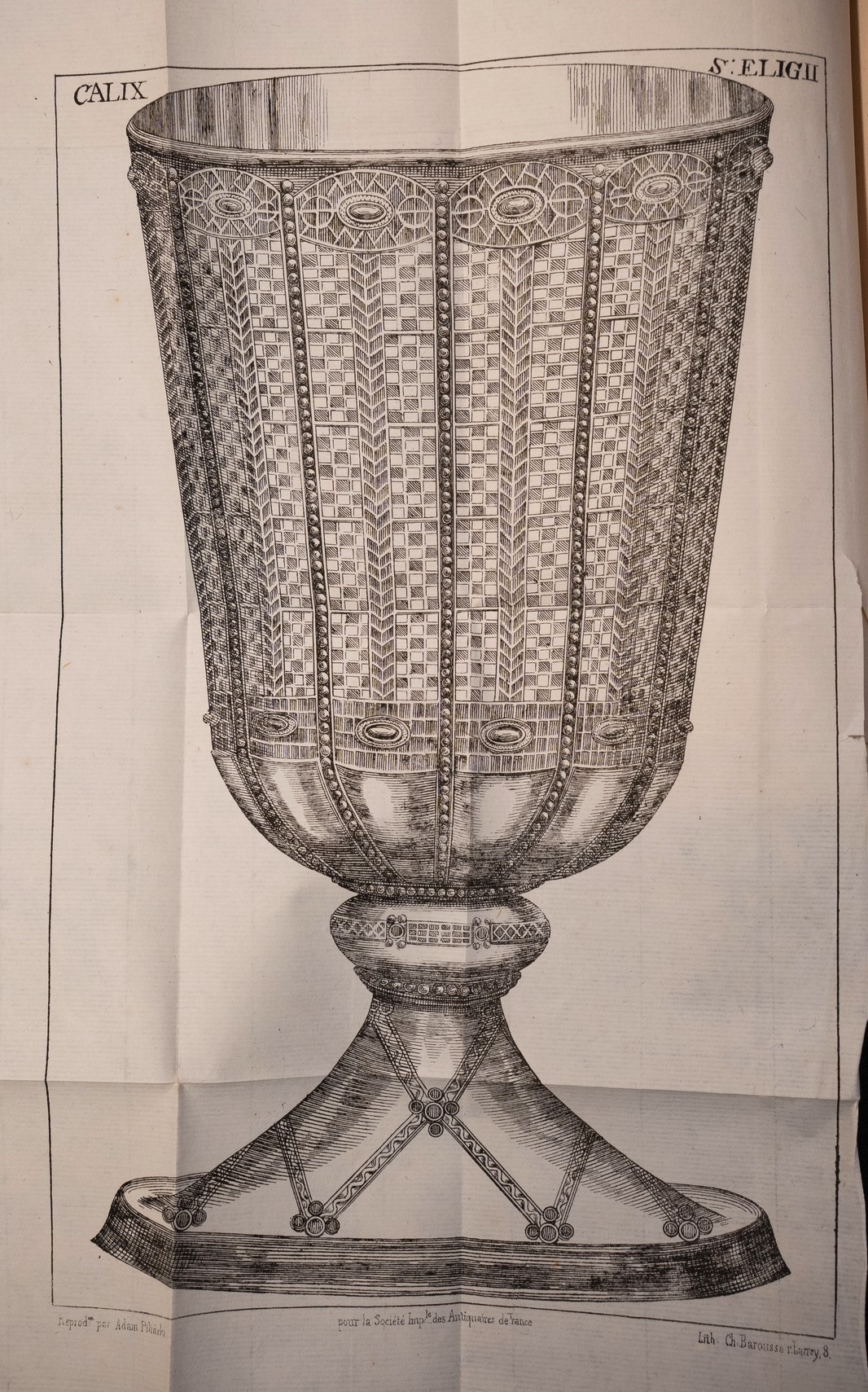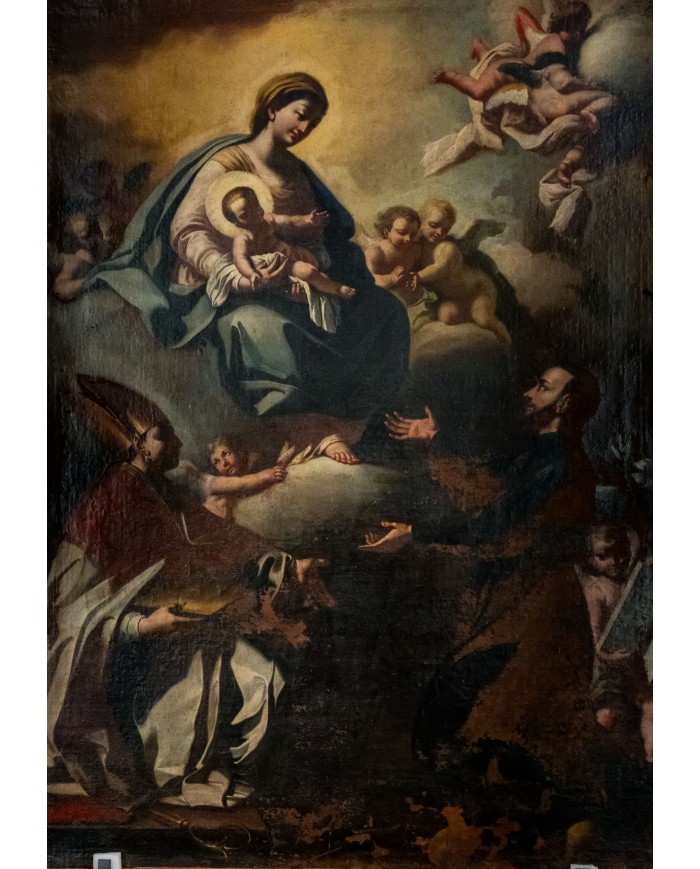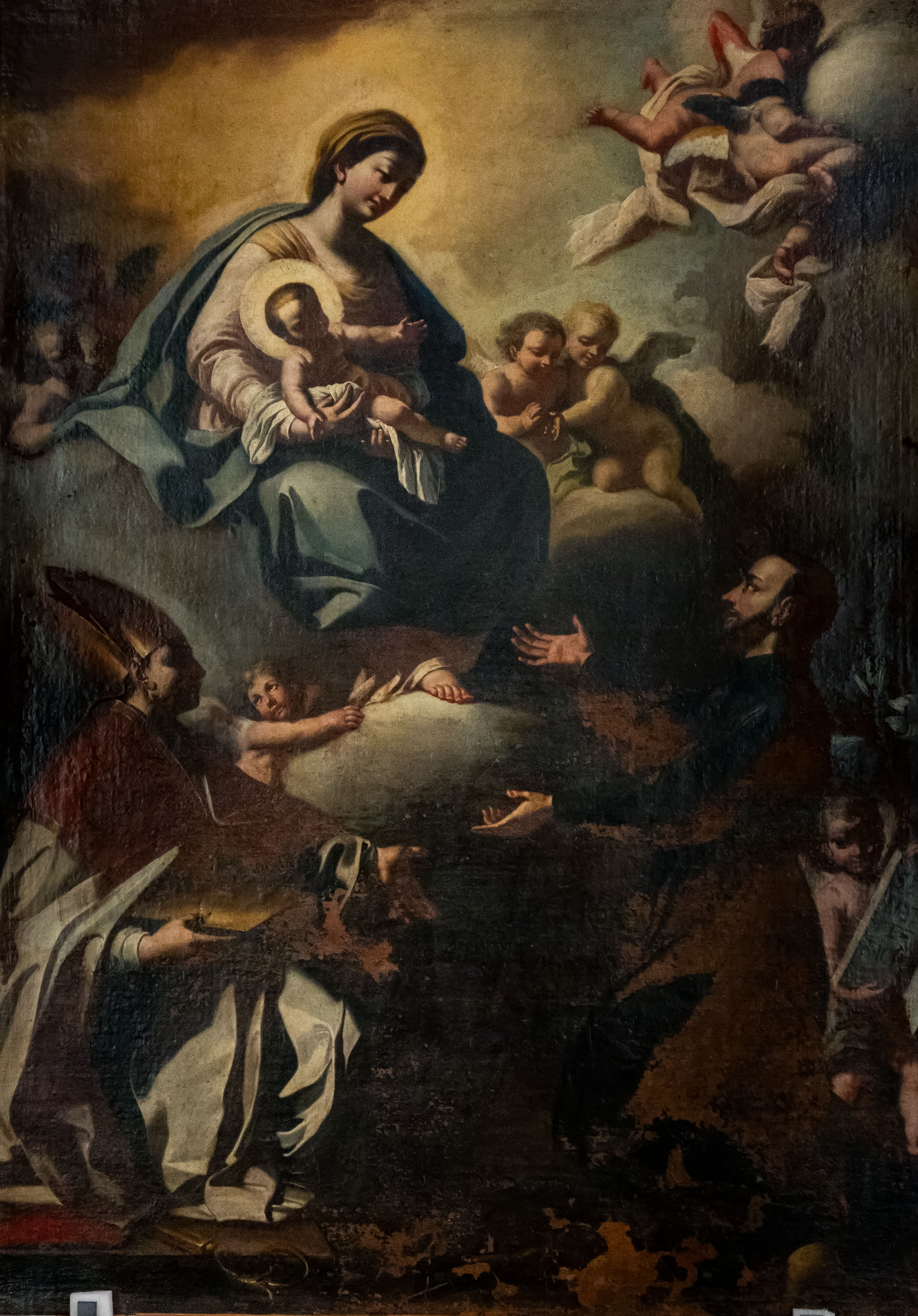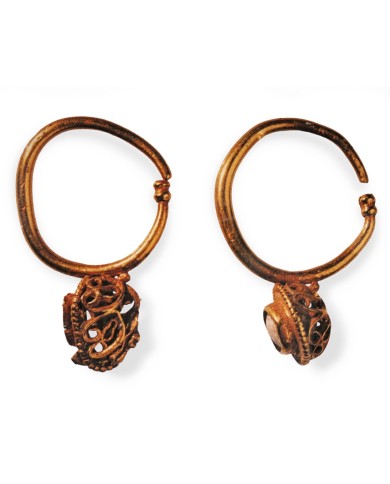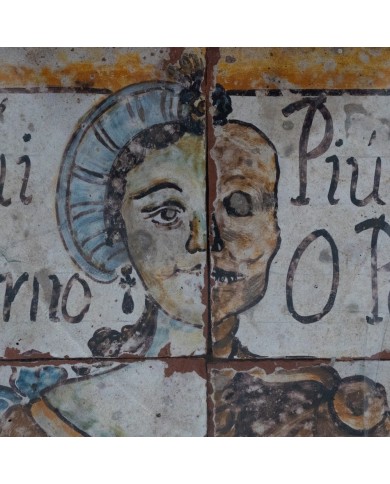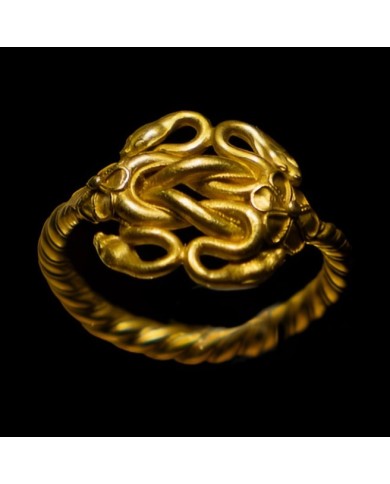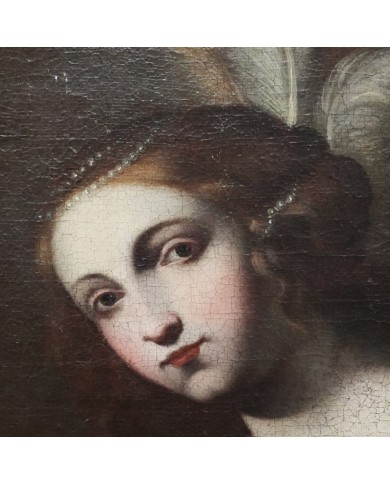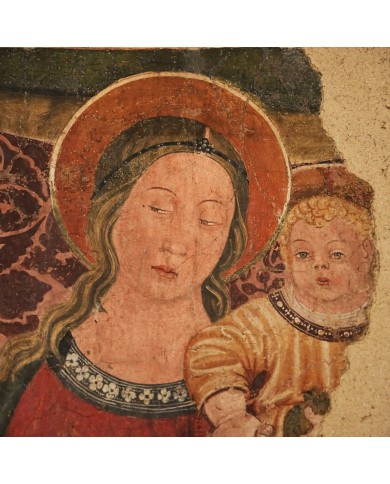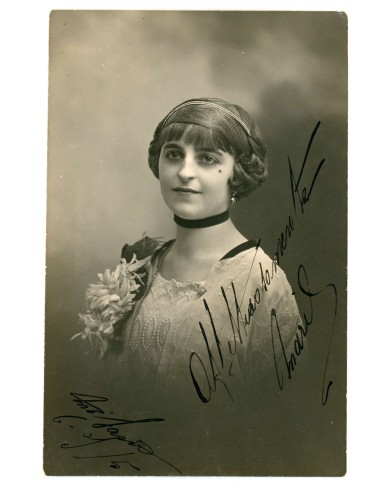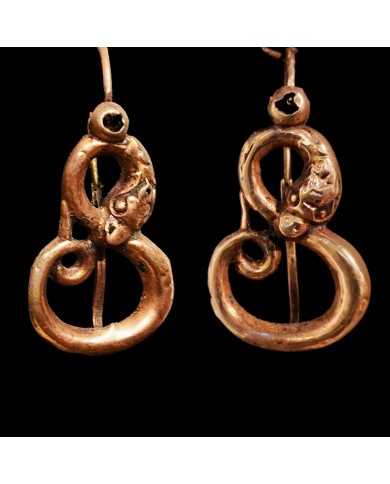St. Eligius, the patron saint of goldsmiths
Sant'Eligio di Nyon, vescovo e protettore degli orefici
Inaugurated in 1986 and collecting works intended for worship or expressions of popular piety, the Diocesan Museum of Vallo della Lucania is the second largest exhibition area in the Cilento, Vallo di Diano and Alburni National Park Area after the National Archaeological Museum of Paestum. Inside, there are a number of interesting things from the goldsmith's point of view on the values of the area. We start with the canvas depicting the Madonna and Child, St Gaetano di Thiene and a bishop saint, St. Eligius, patron saint of goldsmiths and farriers and therefore of particular interest to us.
In this canvas of 1763, of unknown provenance and signed by the Cilento painter Carlo Natale of Castel San Lorenzo, we find the figure of Saint Eligius in the lower right-hand corner in the guise of a bishop, with the mitre on his head, with the crosier resting on the ground next to a closed book and with another book then held in his hand and resting on his leg. These are all elements with which St. Eligius is often depicted, to which are added further and more qualifying ones, such as a pincer and a hammer. To understand why these iconographic attributes are used, we must delve into the life and cult of this French saint.
His biography is known to us thanks to the Vita Eligii written by Audoenus - bishop of Rouen and friend of Eligius, who is said to have written the saint's biography based on direct testimonies and authentic documents - or, as various scholars have argued, it would be a pseudo-Audoenus, i.e. an imitator or continuator of Audoenus, who would have composed the Life after the bishop's death, adding legendary and hagiographic elements. He was probably a monk from Solignac, the monastery founded by Eligius himself. The Vita Eligii allows us to reconstruct his life in three main stages: his training as a goldsmith, his career at the Merovingian court, his conversion to ecclesiastical life with his missionary work.
Training as a goldsmith
Eligius was born in Chaptelat (near Limoges in France) in 588, into a family of Gallo-Roman origin. From a young age he showed a great passion for goldsmithing and went to Limoges to learn the trade from master Abbon, who also ran the royal mint. Here, Eligius distinguished himself for his skill and honesty, so much so that he was noticed by King Clotarius II, who commissioned two gold thrones with precious stones from him. Eligius executed the work with skill and fidelity, returning the metal and gems left over to the king. This earned him the fame and esteem of the sovereign, who appointed him master coin smith.
Career at the Merovingian court
Eligius continued to work as a goldsmith under King Dagobert I, for whom he produced numerous works of sacred art, such as the tomb of Saint Dionysius, the reliquaries of Saint Martin and a large altar cross for Saint-Denis. His works are characterised by the use of precious materials (gold, silver, bronze, enamel), the wealth of decoration (human and animal figures, geometric and plant motifs) and the influence of various artistic styles (Byzantine, Lombard, Irish). Besides his artistic activity, Eligius devoted himself to charity, ransoming prisoners of war and founding monasteries in Solignac, Noyon and Paris. He was also sent on diplomatic missions by the king, such as the one to Armorica (Brittany) in 636-637, where he negotiated peace between the Franks and the Bretons.
Conversion to ecclesiastical life
After Dagobert's death in 639, Eligius gave up his career as a goldsmith and ambassador to the Merovingian court and chose the religious life. In 641, he was consecrated bishop of Noyon-Tournai. From there he engaged in the evangelisation of northern Gaul and the lands of the Frisians where he preached the Gospel with zeal and gentleness, converting many pagans and heretics. He was also involved in the reform of ecclesiastical discipline, the foundation of monasteries and hospitals, the defence of the poor and oppressed, and the promotion of culture and art. The Vita Eligii (and other texts such as the 7th century Chronicon Centulense or the Vita S. Riquieri abbatis Centulensis of the 9th century) inform us that Eligius founded the monastery of Saint-Riquier, where he built a basilica and a bell tower of great beauty, and where he collected many books and sacred objects; the Chronicon Moissiacense, (anonymous compilation from the 9th century) tells us that Eligius sent master blacksmiths to Moissac to teach the monks the art of wrought iron and metalworking; the Liber Historiae Francorum (anonymous compilation from the 8th century) tells us that Eligius gave King Clovis II a gold and silver crown, decorated with enamels and precious stones, that he had made himself.
[FOTO?]
But, besides being a promoter of beauty and art also in his ecclesiastical robes, he was an exemplary shepherd, who lived in poverty and humility, following monastic rules. He also performed several miracles, which demonstrate his holiness and thaumaturgical power. [List of miracles in addition to that of the horse].
[FOTO CON MIRACOLI?]
Eligius died on 1 December 660, after having governed the diocese of Noyon-Tournai for nineteen years. His death was preceded by some prodigious signs, which announced his heavenly glory. According to his biography, written by a pseudo-Audoeno, probably a monk from Solignac, the holy bishop had a vision of Saint Martin, his patron saint, who invited him to prepare for his transit 'Eligius fili mi dilectissime: praepara te; quia dies tuae brevi consummabuntur'. Then, while on his way to Paris, he saw a great light in the sky, which he interpreted as a sign of his imminent departure. Finally, reporting the Vita Eligii in its entirety, "when he had arrived in Clichy; and there in the church of Saint Vincent the Martyr he was praying; behold, a voice from heaven rang in his ears, saying: "Eligius servant of God: come; the Lord is calling you." When Eligius heard this, he immediately fell ill; and he ordered him to be taken to Noyon" where he passed away peacefully, surrounded by his faithful and friends. His body was buried in the church of Saint-Brice in Noyon, where he performed many miracles. His tomb soon became a place of pilgrimage and popular devotion.
The cult of Saint Eligius
The cult of Saint Eligius quickly spread to Limousin, Northern France, Flanders and then Germany. The cult of Saint Eligius also arrived in Italy, particularly in Bologna, where the confraternity of goldsmiths had the church of Sant'Eligio dei Ferrari built in the 15th century, where a relic of his arm was kept. In Rome, the saint was honoured in the church of Sant'Eligio dei Sellai, where a relic of his head was kept, as well as Sant'Eligio dei Ferrari and Sant'Eligio degli Orefici. In Naples, at the request of three French merchants, in 1270 Charles I of Anjou donated land for the construction of a hospital and church, which he named after the French saints Eligius, Dionysius and Martin, the three saints most closely linked to the French monarchy and which, from 1279, was elevated to the veneration of St Eligius alone. The building had the very important function of providing a burial place for foreigners, mostly French and Provençal, who had neither family nor residence in Naples, and who had come to Italy as merchants, soldiers, labourers.
